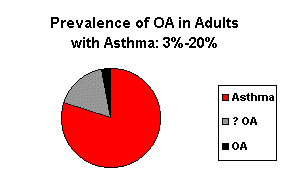Occupational Asthma (OA)
Two Types of Occupational Asthma
Immunologic asthma develops after a variable period of time during which "sensitization" to an agent present in the workplace takes place. Irritant-induced asthma occurs without a latency period after an intense exposure to an irritating dust, mist, vapor, or fume. The pathophysiologic mechanism underlying irritant-induced asthma is not well understood, and it is not known why the asthmatic response persists in certain individuals.1
Two Types of Immunologic OA
The Haz-Map database focuses on immunologic asthma and the predictable and preventable occupational settings in which exposures occur. Immunologic asthma can be classified into that caused by high-molecular or low-molecular weight compounds. The high-molecular-weight compounds are animal and plant derived proteins or polysaccharides such as wheat flour and animal dander that cause an Ig-E-dependent immune response. The low-molecular-weight compounds are chemicals that can also initiate an immune response after repeated inhalation. The nature of the immune response is more complex for the low-molecular-weight chemicals than it is for the high-molecular-weight agents. "An IgE- or IgG-dependent mechanism has not been consistently seen with low-molecular-weight agents (isocyanates, for example). These agents can cause sensitization through a hapten-mediated effect. The role of lymphocytes or other immunologic mechanisms remain unclear."2
The Haz-Map database contains over 180 biological agents and chemicals that can cause immunologic OA based on a previously published table. (Chan-Yeung & Malo and Appendix B in Harber) In the two tables that follow, the high-molecular-weight compounds and wood dusts are listed as "Biological Agents," while the low-molecular-weight compounds are listed in the "Chemicals" table. Wood dusts are biological agents or products, but sensitization may occur through a low-molecular-weight chemical, as has been proven for the case of Western red cedar.
Incidence and Prevalence of OA
In a study done in the West Midlands Region of the United Kingdom, the average annual incidence of occupational asthma was found to be 43 cases per million workers, with a range of 1833 per million for spray painters to eight per million for clerks.3

The prevalence of occupational asthma in adults with asthma is estimated to be between 3% and 20%.
Prevention of Occupational Asthma
The diagnosis of occupational asthma is a sentinel event--an alert that engineering controls or protective equipment could prevent asthma from developing in workers in the same workplace or industry.
References:
- Balmes JR. Occupational Lung Diseases. p. 315 in LaDou
- Malo JL, Cartier A. Occupational Asthma, p. 424 in Harber
- Gannon PF, Burge PS. The SHIELD scheme in the West Midlands Region, United Kingdom. Br J Ind Med 1993 Sep;50(9):791-6. Read Shield reports at the website of the Oasys research group.
- PubMed Abstracts
- See Table 2 from page 6 in Asthma in the Workplace.
- Diagnosis and management of work-related asthma: American College Of Chest Physicians Consensus Statement
Revised May 30, 2018